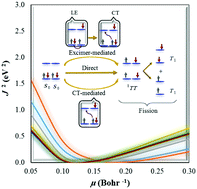Singlet fission relevant energetics from optimally tuned range-separated hybrids†
Abstract
As a promising idea to design high-efficiency organic photovoltaics, singlet fission (SF) mechanism, i.e., generating two triplet excitons out of a single photon absorption, has recently come into the spotlight. Even though much effort has been devoted to this arena, accurately accounting for the SF process from the theoretical perspective has proven to be challenging. Herein, the SF energetics have thoroughly been investigated with the help of optimally tuned range-separated hybrid functionals (OT-RSHs) in both gas and solvent phases. Taking a series of experimentally known SF chromophores as working models, we have proposed and validated several variants of OT-RSH approximations for the reliable prediction of the energy levels which match the crucial criteria for the SF process, namely, the negative singlet–triplet and triplet–triplet energy gaps. We scrutinize the role of the OT-RSH ingredients, i.e., the underlying density functional approximations, short- and long-range exact-like exchange, as well as the range-separation parameter, for our purpose. The newly designed OT-RSHs outperform the standard RSHs and other related schemes such as screened-exchange approximations as well as other density functionals from different rungs for describing the SF energetics. More importantly, it is unveiled that although the OT-RSH coupled with the polarizable continuum model, OT-RSH-PCM, as well as the screened versions, OT-SRSHs, which account for the screening effect by the electron correlation through the scalar dielectric constant have some advantages over gas-phase computations using OT-RSHs, the energetics criteria of the SF process may not necessarily be satisfied. This in turn corroborates the idea of performing both the optimal tuning procedure and subsequent computations of the SF relevant energetics using OT-RSHs as a more reliable and affordable framework, at least for the present purpose. The applicability of the proposed models is also put into broader perspective, where they are used for the computational design of several chromophores as promising candidates prone to utilization in the SF-based materials. Hopefully, our recommended OT-RSHs can function as efficient models for both the theoretical modeling of SF chromophores and confirming the experimental observations in the field.



 Please wait while we load your content...
Please wait while we load your content...